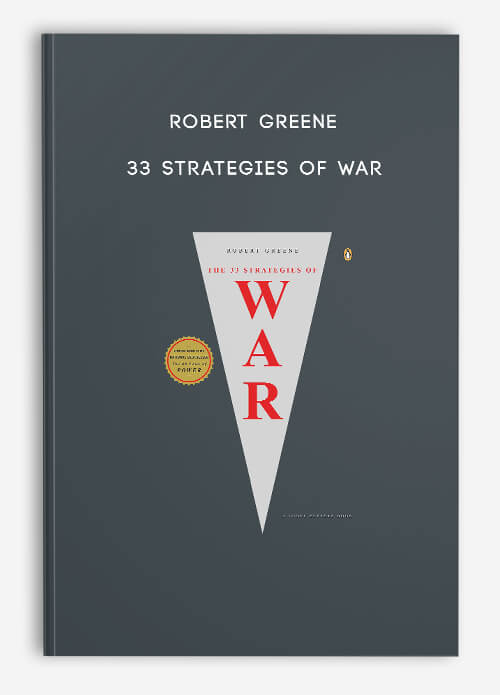33 Strategies Of War by Robert Greene
$19.00
Product Include:
File size:
33 Strategies Of War by Robert Greene
**More information:
Get 33 Strategies Of War by Robert Greene at Salaedu.com
Description
The 33 Strategies of War is a treaty on all the strategies and techniques that have been deployed in war through the ages. But it’s not just about wars, and it’s also applicable to social dynamics.
Contents [show]
Bullet Summary
- First of all, you need to “conquer your own mind”
- Avoid frontal attacks when you can hit the flanks or the sources of power
- Make enemies work for you or infiltrate them. Bloodless wins are the quintessence of strategy
Full Summary
“The 33 Strategies of War” begins with an overview of the key mindsets of war.
Most of all, I liked:
- Look at things as they are: your emotional responses are a disease
As Greene himself stressed in The 50th Law, and as Ray Dalio says in Principles, the men who learn to look at reality for what it is, with dispassionate eyes, holds a huge advantage.
- Judge people by their actions: words are covers to their strategic maneuvers
- Depend on your own arms
Alliances shift easily. You better depend on your own weapons and strengths.
Let him who wants peace prepare for war
Part I SELF-DIRECTED WARFARE
First declare war on the enemies within you.
1: Declare war on your enemies: Polarity Strategy
Do not become a sheep in the crowded center: go to the extreme. A dominating polarizing presence has more pull than middle ground men.
Don’t necessarily get into the idea you need to be liked -as in How to Win Friends-, being respected is better, and even being feared. Don’t be afraid of battles and enemies either. Your enemies give you a purpose and direction.
And battles are what will allow you to win.
And ultimately, it’s victory over your enemies will bring you the most meaningful and lasting popularity.
Victory over your enemies is the best form of popularity
Reversal
Don’t see enemies everywhere, and always keep it for yourself. If you’re wrong, nobody will judge you.
Do like Cortez did. Keep it to yourself, pretend you didn’t notice. Let them come more and more on the surface, and when it’s obvious to everyone they’re enemies, then strike.
And don’t make enemies and pick fights at any time. You don’t want to make enemies of everyone.
2: Do not fight the last war: Embrace Change
Your past successes can be your biggest obstacles if you believe that repeating the same strategy will give you more victories.
Let go of the past, embrace change and fluidity instead.
3: Keep your presence of mind: Counterbalance
Detach yourself from the fog of war and chaos of battles.
The counterbalance to doubt, fear and losing our mind is an intensification of confidence and determination.
Ultimately, it’s preparation and grasp of all details that allows you to see the whole picture. And understanding the trees abut looking at the forest is the main quality of all great generals.
However, let others believe that your Zen qualities come from some mysterious source.
Preparation is key. But let others think you’re gifted
Greene says that we tend to overestimate others and trust ourselves less. Overcompansate it by doing it the opposite: trust yourself more and trust others less.
4: Create urgency and desperation: Death-ground
Creating urgency and desperation means to put yourself and the troops in a position where there’s no other option but winning.
It’s the “burn your bridges” strategy.
Greene recommends to use the thought of death as your driver to spur you into action.
I loved this part as I wrote a whole article about it. If you’re interested in the subject also read: leveraging mortality.
Place yourself where your back is against the wall and you have to fight like hell to get out alive.
Part II ORGANIZATIONAL WARFARE
You’ll rarely win by yourself: you need leadership skills and to bolster team morale.
5: Avoid groupthink: Command-and-control
People naturally have their own agendas in the groups you lead.
If you’re too authoritarian they will resent you, and if you’re too lax they will revert doing their own interests.
You need a chain of command where people buy into your vision and follow your lead naturally.
The overall strategic vision must come from you and you alone. But make the group feel involved in the decision making. Take their good ideas, deflect the bad ones and if necessary make minor changes to appease the most political ones.
The Dangers of Groupthink
People in group tend to act and speak conservatively as they’re all worried of what others think.
That’s not what you need. And that’s why you need unity of command (you).
Beware of Political Animals
Political animals not only are after themselves, but form factions to further their agendas and create their small fiefdoms of power.
You should avoid hiring these people in the first place.
Watch out for those who mirror your ideas 1:1, they’re probably trying to ingratiate you.
If it’s too late, isolate them
Also read:
- Archetypes of office political animals
- The 11 types of toxic employees
6: Segment your forces: Controlled-chaos
Decentralize your army to gain mobility and speed.
The critical elements in war are speed and adaptability–the ability to move and make decisions faster than the enemy.
Break your forces into independent groups that can operate on their own. Give them the spirit of the campaign, a mission to accomplish, and room to run.
7: Transform your war into a crusade: Morale
People are cynical nowadays, speeches and group activities do little.
Build a group myth. Use the past to forge an idea that your group is mythical and legendary. People will feel the pride and work hard to live up to that image.
Those who don’t want to will be forced by the shaming pressure of their own peers.
Don’t push from behind. Make them run to keep up with you
Get them to think less about themselves and more about the group.
Involve them in a cause, a crusade against a hated enemy. Make them see their survival is tied to the success of the army as a whole.
Also read:
- How to become a leader
Part III DEFENSIVE WARFARE
Fighting defensively is not a weakness: tt’s smart strategy.
And in a word that frowns upon direct warfare, making your enemy make the first overt move is the hallmark of great strategy.
8: Pick your battles: Perfect-economy
Not all battles are worth being fought.
The costs of war are high. Even if you do have an enemy, sometimes covert warfare is best.
Think about it shrewdly: Pyrrhic victories are more common than you might think.
Reversal
Once you’re engaged make sure you don’t lose because you’re cutting costs. That’s not economy but stupidity.
9: Turn the tables: Counterattack
Let them go first. Let them believe you’re weak.
Than destroy them with a counterattack once they’re over-stretched.
The best blows are the ones they never see coming
10: Threatening presence: Deterrence
Make your enemy believe you’re too difficult to attack.
Look stronger than they think, build a reputation for fighting till the bitter end, sometimes taking your enemy with you. This works great with enemies who have a reputation.
If you’re smaller, they have little to gain and much to lose.
Or even better: build uncertainty. When the enemy doesn’t know the real costs and dangers, he will stay put.
11: Trade space for time: Nonengagement
Infuriate them by refusing to fight.
Gain time to reflect and rebuild your defenses as they keep over-extending.
Robert Greene also mentions the Murphy’s laws: the more time passes with your enemy on the moves, the more likely it is that something will go wrong (albeit I’d say there are also chances something good will happen to your enemy or that that something bad will happen to you as you wait).
Part IV OFFENSIVE WARFARE
The biggest dangers come from the unexpected. When you attack first at their vulnerabilities you take action and minimize the unexpected.
12: Lose battles & win the war: Grand strategy
Look beyond the present battle and think about the overall war.
Here Greene talks a bit about visualization and successful people who visualized a lot (albeit that’s an inductive reasoning fallacy), reminding me a bit of Think and Grow Rich.
Similar to The Magic of Thinking Big, he recommends you set big goals that will drive you forward.
13: Know your enemy: Intelligence
Similar to his work Mastery, Robert Greene focuses here on the importance of reading people.
Don’t ask too many questions or you’ll put them on the defensive.
Put a friendly, or even subservient front, observe them, let them open up voluntarily. Uncover their weaknesses. And use them.
The most powerful armies are beaten unhinging their leaders’ minds
14: Overwhelm with speed: Blitzkrieg
Move quick, strike first without giving your enemy the time to prepare. Make him emotional, afraid, and error-prone.
15: Control the dynamic: Forcing
Control the battlefield, control the war
The ultimate control is leading the enemy to believe he’s in control.
It works best when you move with his energy, and works best with the aggressive and passive-aggressive types.
Then slowly change the battlefield in a way that suits and makes your enemy uncomfortable.
If the discussion is about money, reframe it as a moral issue.
16: Hit them where it hurts: Center-of-gravity
Don’t exchange punch for punch, that’s the hallmark of stupidity. Look instead at what’s supporting him and strike there.
Your enemy derives its power from a few key sources. Strike there, cut off his lifeline.
Find the source of your enemy’s power. Find out what he cherishes and protects and strike.
17: Defeat them in detail: Divide and Conquer
Sow the seeds of discontent, turn a large enemies into smaller parts. Then attack and conquer.
18: The flank attack: Turning
Frontal attacks are the equivalent of going punch for punch: the sucker’s way of fighting.
The key to a flank attack is disguising your intentions.
19: Envelop the enemy: Annihilation
Encircling deflates your enemy.
Give him the feeling that he’s being attacked from all directions. Phalanxes closing in on him from all directions.
Reversal
With the enveloping strategy you reveal your intention of annihilation. Either you are successful, or you might be left in a difficult position.
20: Maneuver them into weakness
Confuse your opponents so that they don’t know where to defend themselves.
Create disorder, then attack.
Boasting your own skills reeks of self promotion.
Instead, let them speak first and reveal themselves. Now you can use it to your advantage. If they pick an extreme position, say they are dangerous revolutionaries.
If they tone down, say they are inconsistent.
Before the battle begins, put your opponent in a position of such weakness that victory is easy and quick. Create dilemmas where all potential choices are bad.
21: Negotiate while advancing: Diplomatic war
Don’t trust people’s words.
They will break their promises and find moral justifications for their amoral behaviors.
And people will forget broken promises when you’re strong and in the position to offer something they want.
Keep advancing and waging wars during negotiations.
When you keep winning the war you will get better deals and you can use the conquered terrain as bargaining chips. If on the other hand you stop, you will often find your enemy much stronger in battle because he didn’t stop.
It’s even more important you keep advancing when you’re holding the week hand, so you can show resolve.
Act strong and people will treat you as strong.
22: Know how to end things: Exit strategy
How things end is all that matters. The ending is your final judge.
Greene talks here of the quicksands of protracted wars with no end in sight, like the Russians in Afghanistan or the Americans in Vietnam. The only two options in these cases are:
- A major blow that will drive victory home
- Cut your losses and move out
When you see that defeat is inevitable, you can make an effort to go down in style. Planting the seeds of future victory during a defeat is strategy of the highest order.
The Mental Side of Defeat
Defeats are inevitable, so you should learn how to lose gracefully -both for yourself and for others-.
See it as a temporary defeat, welcome it as a way to make yourself stronger, and as a way to demonstrate your character and your strength to stay upbeat even in loss.
Short term defeat is better than long term disaster
Part V UNCONVENTIONAL WARFARE
The greatest element of surprise comes using new strategies that nobody expects.
As people push for novelty though, says Greene, there’s a race to the extremes, leading to dirtier wars.
But you must go dirty yourself. You can’t risk loss out of a sense of morality.
23: Blend fact and fiction: Misperception
Deception is not about making big shows of elaborate distractions.
Most people are aware you’ll try to deceive them and won’t fall for it. The best deceptions mix reality with fiction.
Spread your deceptions to people who believe in the lie themselves, and they’ll work to convince others, naturally, of your deception.
Finally, make up realities that match your enemy’s desire and they’ll deceive themselves into believing it.
24: Line of least expectation: Ordinary-Extraordinary
Greene says that the greatest general have a touch of strategic madness.
As we age though we more and more tend to conform to old habits, and that’s how Napoleone declined and came to rely more on size than on brilliant strategy.
Keep an edge of unconventional instead and break the habits.
25: Occupy the moral high ground: Righteousness
Make your cause seem morally justified and paint your enemy as evil.
Pick a fight with an enemy you can portray as morally corrupt, authoritarian, or power hungry. Don’t drum up your moral superiority but show it: contrast your own life with theirs.
Convince people you’re fighting for a just moral cause and nobody will take note of the tactics you deploy.
I wrote a lot of examples of real life of this. Check:
- Beating the moral police
- Dealing with judgmental people – Charlie Sheen interview
26: Deny them targets: The Void
Let your enemies chase you into emptiness.
Avoid fighting, give them no target. Emptiness will drive them crazy.
The example is Napoleone in Russia.
And another great example is Trump VS Hillary.
27: Seem to act for the greater good: Alliances
Most people operate with feelings and emotions and make alliances based on liking and friendships.
Bad strategy: the best alliances are the ones giving something you can’t get on your own.
Sometimes we think instead that the more allies the better. But it’s not true: the more you have, the more likely it is you’ll be dragged into other people’s wars.
Alliances must be based on mutual interests. See them as stepping stones towards getting what you need.
Finally, never become too dependent on alliances: they will drop you when it best serves them.
Alliances Strategies
Seem like you want to help and let them do the work, then reap the benefits.
You’ll be accused of playing the alliance game, which are nothing but strategic moral attacks. The only real danger is that your reputation will be so tarnished that people won’t wanna ally to you anymore.
But, says Greene:
Self interest rules the world
The example of Murray Bowen was genius. He created a family storm on purpose to bring all back-talking to the surface. Then… Read the book for more.
28: Give rope to hang themselves: One-upmanship
Sometimes enemies are your colleagues, your collaborators.
That’s unconventional warfare at its best as they all try to keep the appearance of working for the greater good.
Don’t attack them head-on: it will only make you look bad and they will have an easy way out.
Look at this Family Guy skit for a preview on how it will end up:
Never attack coworkers directly. It’s easy to make you look like a bad team player
Get under their skin subtly instead. It works best with people who need to perform as they won’t be able to be at their best.
Instill doubts and insecurities in rivals, getting them to think too much and act defensively. Make them hang themselves through their own self-destructive tendencies, leaving you blameless and clean.
Rigid types who cannot stand breaking moral codes are the easiest to one-up. They will overreact and attack you too obviously, making them look vindictive.
29: Take small bites: Fait Accompli
Most people cling to status quo and are loath of starting wars over trivial matters.
That’s why you will take small bites, bite by bite. Every time it will be too small to start a war and once you take enough bites they won’t even be able to wage war against you.
30: Penetrate their minds: Communication
The goal of communication is to further your interest, to penetrate the enemies’ minds. Anything else is self indulgent talk.
Make people reach your conclusions and let them believe it was their own ideas.
Very interesting analysis of The Prince here by Robert Greene and how also writing must be focused to spreading your ideas to be effective.
31: Destroy from within: The Inner Front
Instead of fighting your enemies: join them.
Infiltrate their ranks, rise to the top. Then slowly get what you want or stage a coup.
The example here was that of Canaris, a high ranking officer in Hitler’s spy networks. I was very surprised to read the story as I had never heard about it.
Basically this guy was one of the biggest influences in the Nazi’s loss and no history books has ever mentioned him.
32: Seeming to submit to dominate: Passive-Aggression
Seem to submit and go along with them.
Disguise your aggression so you can deny it even exists.
People are not well equipped to see both aggression and submission at the same time and will usually just go along with one.
Make sure your front is spotless.
It’s also difficult to fight people who fight without violence. If your enemy attacks, they will look terrible and justify further revolts. If they let you go, you can grow your clout (Gandhi example).
Dealing With Passive Aggression
In a world that despises full aggression, passive aggression is on the rise.
First of all, eliminate any feeling of guilt you might have when they show the passive side.
Whenever you can, disengage. When you can, never attack directly, but use their own tactics right back.
If it’s a partner in a relationship, make them feel safe to express themselves.
Also read:
- Passive aggressiveness
Examples:
Roosvelt pretending he didn’t want to run for a third time, so nobody could accuse him of being power hungry.
When people asked for him, he showed up almost as if he had to oblige.
Partners in relationships who try to force the other into what they want while denying doing so.
33: Sow panic with terror: Chain Reaction
Terror strategies aim at raising havoc, making enemies fearful and provoking desperate overreactions -or surrenders without fighting-.
They serve well to smaller groups who can’t fight openly because of size disparity.
Their goal is to spread fear with small acts of violence that reverberate through stories and media and command outsized attention compared to their real effect.
Counterstrategies include keeping calm and rational and alienating the terror groups from the masses to deny any political base (Brigate Rosse in Italy).
Stopping the terror from spreading is also important (UK managing V2 terror), and heavy military engagement from the stronger side is often a mistake (what happened to the US recently).
Examples:
Mongols and spreading stories of their horrors so enemies would give up without a fight.
Robespierre and holding to power through an actually peaceful time thanks to the fear he instilled in enemies and people alike.
1 review for 33 Strategies Of War by Robert Greene
Add a review Cancel reply
Related products
Everything Else
Everything Else
Everything Else
Aaron Lynch – Ultimate Gann Course Coaching Safety in The Market COMPLETE 12 Modules
Everything Else
Caroline Oceana Ryan – The Ascension Manual: A Lightworker’s Guide to Fifth Dimensional Living











king –
We encourage you to check Content Proof carefully before paying.“Excepted” these contents: “Online coaching, Software, Facebook group, Skype and Email support from Author.”If you have enough money and feel good. We encourage you to buy this product from the original Author to get full other “Excepted” contents from them.Thank you!